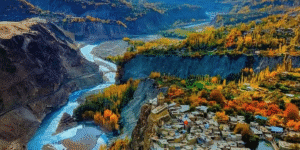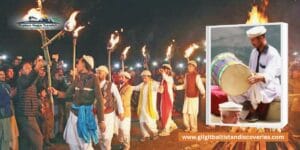Frozen lakes in Gilgit Baltistan are a true highlight of winter travel in Gilgit Baltistan, transforming the landscape into a mesmerizing wonderland. Here’s how you can describe them to capture the essence of this unique experience:
Table of Contents
ToggleBeauty and Spectacle
Sparkling Masterpieces
This point vividly depicts the breathtaking sight of frozen lakes under the winter sun. The vast expanse of ice, reflecting the sunlight like countless diamonds, creates a stunning spectacle that would leave anyone speechless. Imagine the sparkling surface stretching out towards the majestic snow-capped peaks, creating a scene of unparalleled beauty.
Frozen landscapes
This point focuses on the serene atmosphere of the icy lakes. The stillness of the ice adds a sense of tranquillity to the already impressive mountain scenery. It’s an opportunity to be present in the moment, to truly connect with the raw beauty of nature without the usual distractions. The frozen landscape invites you to slow down, breathe deeply, and appreciate the quiet grandeur of the mountains.
Hidden wonders
This point highlights the unique opportunity to discover hidden treasures when the lakes freeze. Lakes like Satpara and Blind Lake, ordinarily inaccessible due to water, become open for exploration when frozen. It’s like stepping into a secret world, discovering hidden paths, frozen waterfalls, and secluded coves that remain hidden during the warmer months. This adds an element of adventure and discovery to the experience, making it even more unforgettable.
Activities and Adventure
Ice Skating Paradise
This point transforms the frozen lake into an inviting playground for novice and seasoned skaters. Imagine the thrill of gliding effortlessly across the smooth ice, leaving trails behind you like brushstrokes on a canvas. The wind whips through your hair as you dance across the vast expanse, creating a magical experience that blends freedom and exhilaration. Whether taking tentative steps on the ice or carving graceful pirouettes, the frozen lake becomes your rink, offering a unique and joyful winter activity.
Photography Haven
This point highlights the frozen lake as a treasure trove for photographers of all skill levels. The unique combination of elements, the ethereal light reflecting off the ice, the vibrant hues of the surrounding mountains, and the intricate patterns frozen within the ice create a scene begging to be captured. Further, imagine zooming in on the delicate veins of the ice, capturing the mirrored image of the peaks above, or documenting the tracks of birds dancing across the pristine surface. The frozen lake offers endless possibilities for creative expression, turning every shutter click into a chance to immortalize its captivating beauty.
More Suggested Readings: Best Places to Visit in Hunza and Ghizar Valley
Winter Sports Playground
This point showcases the adventurous potential of some frozen lakes. Places like Attabad or Kachura become winter wonderlands for those seeking more stunning-pumping activities. Furthermore, imagine casting your line through a hole in the ice, hoping to lure a hidden fish from the depths of the frigid water. Or picture yourself strapped into snowshoes, traversing the frozen surface, leaving footprints in the untouched snow. For the truly daring, imagine scaling the icy cliffs of a frozen waterfall. What’s more, the exhilarating challenge is matched only by the breathtaking views from the summit. These lakes transform into winter sports playgrounds, catering to every level of adventurous spirit, from the peaceful thrill of ice fishing to the heart-pounding rush of ice climbing.
Read More: Role of Winter Sports in Gilgit Baltistan
Glimpsing into the Heart of Gilgit Baltistan
Frozen lakes in Gilgit Baltistan aren’t merely stunning backdrops for adventure. They are woven into the fabric of local culture, holding stories and traditions as old as the mountains.
Local Traditions
For centuries, these frozen giants have served as lifeblood for communities, not just as water sources but as arteries for transportation and wintertime activities. Imagine traversing the icy expanse on a horse-drawn sleigh, the crunch of ice underfoot and the crisp air biting at your cheeks. Picture families gathering on the frozen surface, playing traditional games like “shaga” (a stick-throwing competition), or enjoying a picnic under the winter sun. Finally, these activities, passed down through generations, showcase the resilience and resourcefulness of these mountain communities, which have adapted to thrive in this harsh yet breathtaking environment.
Read More: Famous Dishes of Gilgit-Baltistan
Winter Festivals
The arrival of winter isn’t simply a change in season; it’s a cause for celebration! Villages near frozen lakes come alive with vibrant festivals, transforming the icy landscape into a canvas of joy. Imagine the rhythmic beat of drums echoing across the frozen surface as communities gather for traditional dances like “Yarkhu” or “Chhapi.” Witness the colorful spectacle of men and women adorned in their finest robes, their smiles as radiant as the sun reflecting off the ice. Also, these festivals are a testament to the region’s rich cultural heritage, a chance to immerse yourself in the warmth of local hospitality amidst the icy beauty.
Exploring the cultural significance of frozen lakes in Gilgit Baltistan is like going on a journey through time, where ancient traditions and modern resilience intersect. Both are equally important.
It’s a chance to witness the unwavering spirit of these mountain communities, their love for their land, and their ability to embrace the beauty and challenges that winter brings. By stepping onto the frozen surface, you’re not just entering a stunning landscape but a world steeped in history, culture, and the warmth of human connection.
Preserving a Winter Wonderland
While the attraction of frozen lakes in Gilgit Baltistan lies in their breathtaking beauty and exhilarating activities, venturing into this winter wonderland comes with responsibilities beyond simply snapping a stunning photo.
Respect and Safety
Remember, these frozen landscapes are not just playgrounds but fragile ecosystems teeming with life. Be a responsible visitor by following safety guidelines:
- Refrain from venturing onto thin ice. Always stay on marked paths and designated areas.
- Beware of hidden cracks and crevasses. The ice may appear solid, but hidden dangers lurk beneath.
- Dress appropriately for the harsh conditions. Hypothermia can set in quickly in these freezing temperatures.
- Leave no trace behind. Respect the pristine environment by bringing your waste and disposing of it properly.
Sustainable Tourism
Choose tour operators who prioritize environmental protection and respect local customs. But, Opt for activities that minimize harm to the ecosystem and support local communities. Here are some ways to be a responsible tourist:
- Minimize transportation emissions. Choose eco-friendly travel options like walking, cycling, or using public transport.
- Patronize local businesses. Support the communities that depend on tourism for their livelihood.
- Learn about local customs and traditions. Be respectful of cultural norms and dress codes.
- Help preserve the natural beauty. Avoid activities that litter or damage the environment.
By choosing responsible tourism, you can ensure that these breathtaking winter landscapes are preserved for future generations. Remember, your visit should leave only footprints, not permanent scars, on this majestic region.
In essence, venturing beyond the beauty of frozen lakes means becoming a steward of this natural wonder. It’s about balancing your desire for adventure with respect for the environment and the local communities that call it home. Only then can you truly experience the magic of Gilgit Baltistan in winter, leaving behind only positive memories and a commitment to sustainable exploration.
Most popular frozen lakes in Gilgit Baltistan to visit
Satpara Lake
Satpara Lake is a breathtaking natural wonder in the stunning mountains of Skardu Valley, Gilgit-Baltistan, Pakistan. A popular stop for tourists traveling from Skardu towards the Deosai Plains, the lake offers stunning scenery and a chance to experience the region’s tranquility.
Location
Satpara Lake is a gem in Skardu Valley, Gilgit-Baltistan, Pakistan. It’s a popular stop for tourists traveling from Skardu to the Deosai Plains, which is just a 30-minute drive away.
Natural Beauty
Satpara is a natural lake at a refreshing elevation of 8,650 feet (2,636 meters) and boasts a surface area of roughly 2.5 square kilometers. The construction of the Satpara Dam downstream has further enhanced its size. The highlight of the lake is a picturesque island in its center, adding to its charm.
Water Source
Satpara Lake’s crystal-clear blue water is primarily fed by the Satpara Stream, which originates from the melting glaciers of the Deosai Plains. As a source of freshwater, Satpara Lake is vital in supplying water to Skardu Valley.
Activities
Visitors can enjoy scenic boat rides around the lake while swimming isn’t recommended due to the cold water. The surrounding area is perfect for a leisurely picnic or a short hike to enjoy the panoramic views.
Nearby Attractions
An interesting side trip near the lake is a Buddha carving etched into the mountain. A few restaurants are scattered along the road near the lake for those looking for refreshments.
Whether seeking a scenic stopover or a chance to commune with nature, Satpara Lake offers a delightful experience for travelers venturing through the region.
Attabad Lake
Attabad Lake, a marvel born from a natural disaster, is a mesmerizing gem in the Gojal Valley of Gilgit-Baltistan, Pakistan. This relatively young lake, formed in 2010, has become a popular tourist destination, captivating visitors with its vibrant turquoise waters and dramatic mountain backdrop.
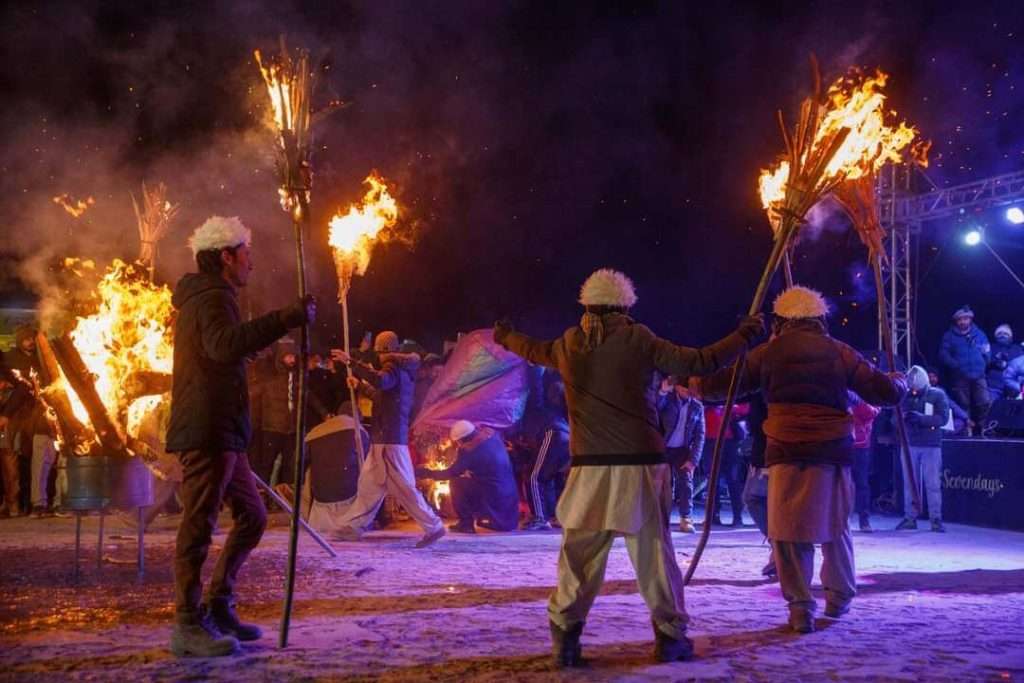
Let’s explore deeper into the unique characteristics of Attabad Lake:
Location
Located in the Gojal region, the lake stretches for 14 kilometers (approximately 9 miles) upstream from Karimabad, a town in Hunza District. The Hunza River, once flowing freely, now feeds this scenic lake.
A Dramatic Birth
A massive landslide marks Attabad Lake’s origin story in January 2010. The landslide tragically claimed lives and blocked the flow of the Hunza River for several months. Over time, the accumulated water formed this captivating lake.
A Landscape of Beauty
Attabad Lake boasts a captivating panorama. The crystal-clear turquoise water reflects the majestic peaks of the surrounding mountains, creating a picture-perfect scene. The dead tree trunks still submerged in the lake are a poignant reminder of its dramatic formation.
Activities Galore
Attabad Lake offers a variety of activities for visitors to enjoy. Take a relaxing boat ride or try jet-skiing on the pristine waters. Fishing enthusiasts can cast their lines for trout, while photographers can capture stunning scenery shots. In the winter, the lake transforms into a wonderland, offering opportunities for winter sports.
A Flourishing Tourist Hub
Since its formation, Attabad Lake has become a major tourist attraction in Gilgit-Baltistan. Several resorts and hotels have sprung up around the lake to accommodate the influx of visitors.
Despite its relatively young age, Attabad Lake has carved a niche as a must-visit destination in Pakistan. Whether you seek breathtaking scenery, exciting activities, or a glimpse into the forces of nature, Attabad Lake offers an unforgettable experience.
Kachura Lake
Kachura Lakes are located near the Deosai Plains of the Karakoram mountain range in Gilgit-Baltistan, Pakistan. These aren’t just one, but a collection of three stunning lakes – Upper Kachura, Lower Kachura (also known as Shangrila Lake), and Zambakha Lake – each offering a unique charm.
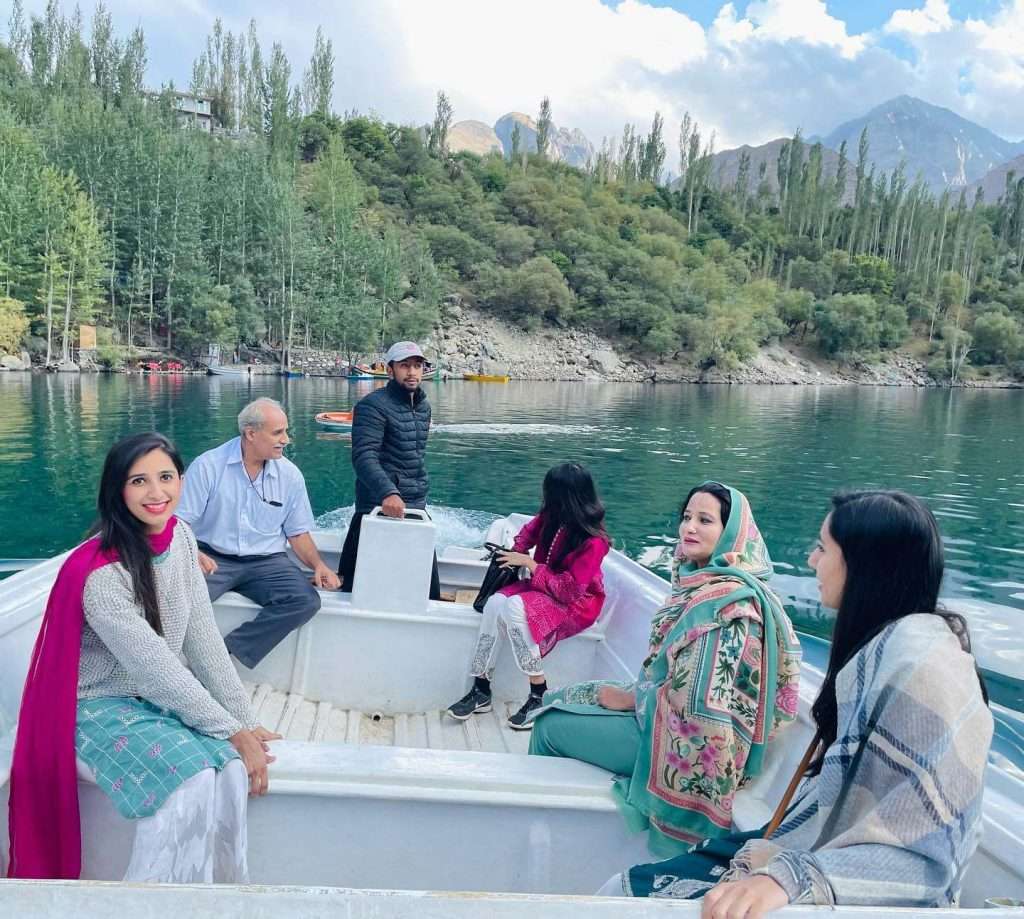
Let’s explore the wonders of the Kachura Lakes:
Location
The Kachura Lakes reside in the Skardu District, Gilgit-Baltistan, approximately 2,500 meters (8,200 feet). Lower Kachura Lake is conveniently located just 30 minutes by car from Skardu town.
A Trilogy of Beauty
- Upper Kachura Lake: This gem, mostly unexplored due to its rugged terrain, boasts clear waters with a depth of 70 meters (230 feet). Hikers can reach this hidden treasure for a taste of serenity amidst nature.
- Lower Kachura Lake (Shangrila Lake): This easily accessible counterpart to the Upper Lake is a popular tourist destination. Often referred to as Shangrila Lake, it lives up to its name with its picturesque setting and a resort established on its banks in 1983.
- Zambakha Lake: Located in the tiny village of Zambakha, this lesser-known lake offers a tranquil escape, perfect for those seeking solitude amidst nature.
A Paradise for Nature Lovers
The surroundings of the Kachura Lakes are teeming with life. Visitors can spot apricots, cherry trees, golden marmots, and various birds, creating a delightful natural experience.
Activities and Relaxation
While the Upper Kachura Lake is ideal for adventurous hikes, the Lower Kachura Lake caters to a wider range of interests. Enjoy a relaxing boat ride on the lake’s surface, try your hand at trout fishing, or take in the breathtaking views. The Kachura Lakes transform into a wonderland for winter sports enthusiasts during winter. The frozen surface becomes a playground for ice climbing and snowshoeing, offering a unique and thrilling experience.
The Kachura Lakes offer something for everyone. Whether you’re a seasoned adventurer or simply seeking a peaceful escape, this trio of lakes promises an unforgettable experience in the heart of the Pakistani mountains.
Blind Lake
Located in the stunning mountains of Shigar Valley in Gilgit-Baltistan, Pakistan, Blind Lake a captivating yet mysterious body of water. Unlike its crystal-clear counterparts, Blind Lake holds a unique charm due to its very name – its source and discharge point remain unknown.
Let’s get into the intrigue surrounding Blind Lake:
Location
This hidden gem is approximately 30 minutes by car from Skardu City on the way to Shigar Valley. A local driver familiar with the area can help you find it easily.
A Veil of Mystery
Blind Lake’s local name, Zharba Tso, translates to “Blind Lake” in English. This name is due to the obscurity of its water source and discharge point. The lake seems to exist in isolation, surrounded by the Indus and Shigar rivers, yet not visibly connected to either. This mystery adds to the allure of Blind Lake, sparking curiosity among visitors.
A Haven of Beauty
Despite the mystery surrounding its source, Blind Lake boasts undeniable beauty. The still water reflects the surrounding mountains, creating a picture-perfect scene. The surrounding landscape offers a mix of sand, rocks, and patches of lush green grass, perfect for a picnic or a leisurely stroll.
Activities and Tranquility
While swimming isn’t recommended due to the unknown water source, visitors can enjoy a serene boat ride on the lake’s surface. The quiet and peaceful atmosphere makes Blind Lake ideal for those seeking an escape from the hustle and bustle of everyday life. Camping near the lake at night offers a chance to witness a spectacular display of stars against the backdrop of the mountains.
A Bonus for Adventurers
For adventure enthusiasts, Blind Lake serves as a starting point for exploring the surrounding areas. You can embark on a jeep safari to explore the nearby Skardu Fort or venture further into the Shigar Valley for a deeper immersion in the region’s culture and landscapes.
Blind Lake beckons with its unique charm. Whether captivated by the mystery of its source or simply seeking a tranquil escape surrounded by beauty, this hidden gem in Pakistan promises a memorable experience.
Khalti Lake
This is another one of the frozen lakes in Gilgit Baltistan. Khalti Lake is beautiful in the Gupis-Yasin District of Gilgit-Baltistan, Pakistan. Here’s what you should know about it:
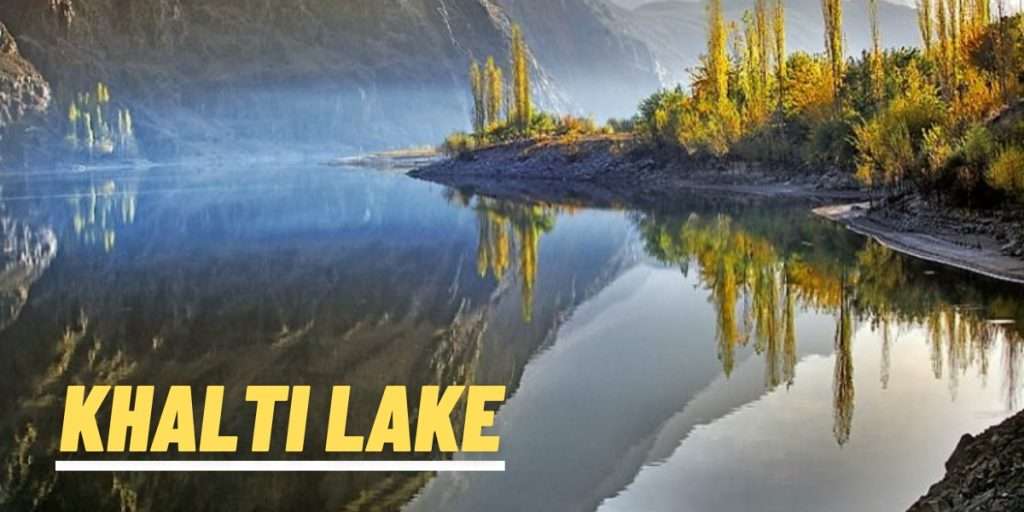
Location
The lake is around 6 kilometers from Gupis, a town on the Gilgit-Chitral Road. It’s easily accessible by car and visible from the main road.
Formation
Khalti Lake is a widened and deepened section of the Gilgit River near Khalti village.
Scenic Beauty
The lake is known for its stunning emerald-blue water, surrounded by the Hindu Kush mountains. The area is known for its peace and tranquility, offering a chance to relax and listen to birds singing.
Activities
In the summer, visitors can enjoy activities like boating and fishing for trout, which the lake is known for. In the winter, the lake freezes over.
Nearby Facilities
A few restaurants are near the lake, where you can grab a bite while enjoying the view. The PTDC motel is also nearby, offering accommodation with a scenic lake view.
Overall, Khalti Lake is a must-visit destination for anyone traveling to Gilgit-Baltistan. Whether you’re looking for a place to relax, enjoy the scenery, or try your hand at fishing, Khalti Lake has something to offer everyone.
Rush Lake
Rush Lake isn’t your typical lake destination. Located in the stunning peaks of the Karakoram in Gilgit-Baltistan, Pakistan, this high-altitude wonder sits at a staggering 4,694 meters (15,400 feet), making it one of the world’s highest alpine lakes and the crown jewel of Nagar Valley. But there’s more to Rush Lake than its lofty perch – it’s a frozen wonderland for most of the year.

Here’s what makes Rush Lake a must-visit for adventure seekers:
A Trekker’s Dream
Reaching Rush Lake is an adventure in itself. The lake isn’t accessible by car—it’s a reward for going on a challenging yet rewarding trek through the Nagar Valley. Hikers traverse glaciers and high meadows and witness the captivating beauty of the surrounding mountains. Popular routes approach the lake from Hopper Village, offering stunning views of the Hopper Glacier and Miar Glacier.
A Frozen Paradise
Rush Lake remains frozen for a significant portion of the year due to its high altitude. The short summer window, typically only 2-4 months, offers a glimpse of the lake’s pristine waters reflecting the snow-capped peaks. Rush Lake transforms into a magical landscape of ice and snow for the rest of the year.
A Feast for the Senses (Summer & Winter)
Whether you visit during the summer thaw or the winter freeze, Rush Lake offers a feast for the senses. In summer, witness the dramatic contrast of rugged mountains, lush green valleys, and clear blue waters. In winter, experience the serene beauty of a frozen landscape, untouched and pristine.
A Challenge for Climbers
Rush Peak stands tall near the lake at 5,098 meters (16,725 feet), offering an extra thrill for those seeking an extra challenge. Scaling this peak is challenging for experienced climbers, but it offers even more awe-inspiring views of the surrounding ranges.
A Cultural Encounter
The trek to Rush Lake isn’t just about the destination. It’s also a chance to experience the culture of the Nagar Valley. Trekkers may encounter small villages and hospitable locals who can offer a glimpse into their way of life.
Planning Your Expedition
Given the challenging nature of the trek and the short summer window, reaching Rush Lake requires proper planning and guidance. Enlisting the help of experienced tour operators and guides familiar with the region is crucial for a safe and successful journey.
A Once-in-a-Lifetime Experience
Rush Lake isn’t for everyone. But for those seeking an adventure steeped in breathtaking scenery, cultural immersion, and a touch of challenge, it’s an experience unlike any other. In addition, this high-altitude gem, frozen in time for much of the year, promises a story you’ll tell for years.
Kacheli Lake
Kacheli Lake isn’t your average lake. It’s a hidden gem nestled amidst the lush meadows of the Miachar Valley in Nagar District, Gilgit-Baltistan, Pakistan. While not as high as Rush Lake, Kacheli Lake sits at a respectable altitude (around 3,200 meters or 10,500 feet), offering a taste of alpine beauty with a moderate trek. This altitude also influences the lake’s character throughout the year.
Read More: Things to do in Nagar Valley
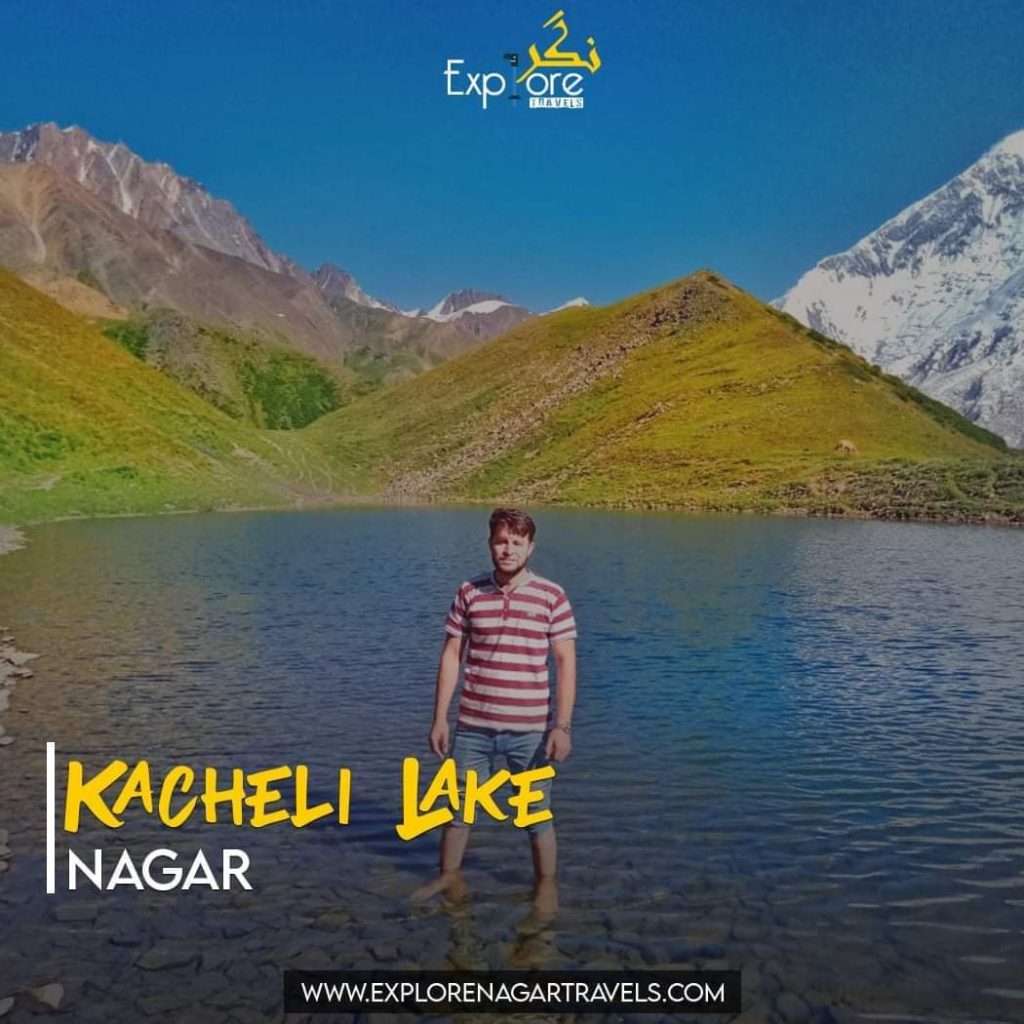
Here’s what makes Kacheli Lake a captivating destination:
A Scenic Trek
Unlike Rush Lake’s challenging climbs, reaching Kacheli Lake involves a scenic trek through the Miachar Valley. From the town of Minapin, the trail winds through meadows bursting with wildflowers, offering a chance to witness the region’s natural splendor.
A Picturesque Mountain Backdrop
As you ascend towards Kacheli Lake, the majestic peaks of Rakaposhi and Diran Peak come into view, creating a stunning backdrop for the lake. The lake’s turquoise waters reflect these giants, making for a picture-perfect scene.
A Haven for Hikers
Kacheli Lake is a popular destination for trekkers exploring the Rakaposhi Base Camp or Diran Peak. The moderate hike to the lake is a perfect rest stop or a side trip before tackling the more challenging climbs.
A Tranquil Escape
The serene beauty of Kacheli Lake makes it ideal for those seeking a peaceful escape. The clear mountain air, the gentle sound of water, and the breathtaking scenery offer a chance to relax and rejuvenate amidst nature’s embrace.
Simple Facilities
While not a luxurious destination, basic amenities like campsites and local tea houses can be found near Kacheli Lake. These cater to trekkers seeking a comfortable yet rustic experience.
Planning Your Visit
The ideal time to visit Kacheli Lake is during the summer months (June to August) when the weather is pleasant and the meadows fully bloom. During these summer months, the lake thaws and reveals its turquoise beauty. However, Kacheli Lake freezes over in winter (December to February) due to its altitude. The lake becomes a part of the winter wonderland, offering a different kind of scenic beauty.
A Breathtaking Stopover in Any Season
Kacheli Lake, with its scenic approach and captivating beauty, offers a delightful stopover for travelers exploring the wonders of the Nagar Valley throughout the year. Whether you’re a seasoned trekker seeking a summer respite or a winter wonderland enthusiast, Kacheli Lake promises a memorable experience based on the season you choose to visit.
Frozen Lakes in Gilgit Baltistan Conclusion
The Frozen Lakes in Gilgit Baltistan are more than just breathtaking landscapes; they are portals to a world of wonder and adventure. They shimmer like diamonds under the winter sun, their stillness mirroring the majesty of the surrounding peaks. They offer a canvas for ice skating pirouettes, capture captivating photographs, and hold the whispers of ancient traditions on their frozen surface.
But beyond the beauty, these lakes whisper stories of resilience and adaptation. Local communities have woven their lives around these icy giants, using them as pathways, sources of life, and grounds for joyous winter festivals. Immersing yourself in their cultural tapestry unveils a warmth that radiates even amidst the chill of winter.
Wonderland Requires Respect and Responsibility
However, venturing into this wonderland requires respect and responsibility. Tread cautiously, adhering to safety guidelines and protecting the delicate ecosystem. Choose sustainable travel options and support local communities, ensuring future generations can experience this magic just as you have.
So, embrace the call of the Frozen Lakes in Gilgit Baltistan. Let the wind whip through your hair as you glide across the ice, capture the ethereal beauty in your lens, and connect with the warmth of local traditions. Moreover, you are not just a visitor; you are a guardian of this winter wonderland, leaving behind only footprints and a deep appreciation for its unparalleled beauty.
Are you ready to visit Frozen Lakes in Gilgit Baltistan?
Finally, let the memories of your encounter with these frozen charms of Gilgit Baltistan stay with you long after the winter sun melts the ice. It truly is an experience that will leave you breathless, invigorated, and forever enamored with the magic of a world transformed into a glistening, crystalline wonderland.
- Have you dreamed of experiencing this winter magic yourself? In the comments below, share your plans for visiting the Frozen Lakes in Gilgit Baltistan!
- Do you have questions about navigating these icy landscapes or cultural insights you’d like to share? Let’s build a community of frozen lakes enthralled adventurers together!
FAQs about the Frozen Lakes in Gilgit Baltistan
When are the frozen lakes accessible?
The best time to experience the frozen lakes is typically from December to February, when temperatures plummet, and the ice thickens enough for safe travel. However, this can vary depending on the specific lake and altitude, so it’s always best to check current conditions.
What activities can I enjoy on the frozen lakes?
The possibilities are endless! Here are just a few ideas:
- Ice skating: Glide across the smooth lake surface, surrounded by breathtaking mountain views.
- Ice fishing: Cast your line through a hole in the ice and try to catch a local fish.
- Snowshoeing: Explore the frozen landscapes and hidden coves on foot.
- Ice climbing: For the adventurous souls, tackle the icy cliffs and waterfalls surrounding some lakes.
- Photography: Capture the stunning beauty of the frozen lakes and the surrounding mountains.
- Cultural experiences: Participate in traditional winter festivals, learn about local crafts and traditions, and experience the warm hospitality of the people.
What safety precautions should I take?
Always prioritize safety when venturing onto frozen lakes. Here are some essential tips:
- Never walk on thin ice. Always stay on marked paths and designated areas.
- Dress warmly in layers. The temperatures can be frigid, especially on windy days.
- Wear proper footwear with good traction.
- Be aware of the weather conditions. Avoid going out if there is a risk of snow or ice storms.
- Let someone know your plans and expected return time.
- Respect the environment and leave no trace behind.
How can I plan a responsible trip to the frozen lakes?
Choose tour operators who prioritize environmental protection and respect local customs. Here are some ways to be a responsible tourist:
- Minimize transportation emissions. Choose eco-friendly travel options like walking, cycling, or using public transport.
- Patronize local businesses. Support the communities that depend on tourism for their livelihood.
- Learn about local customs and traditions. Be respectful of cultural norms and dress codes.
- Help preserve the natural beauty. Avoid activities that litter or damage the environment.
By following these tips, you can have an unforgettable and responsible experience exploring the Frozen Lakes in Gilgit Baltistan.
Ready to go on your winter wonderland adventure? Share your questions, travel plans, or any additional insights in the comments below! Let’s make the most of our frozen lake explorations together.
Read More: Mountain Climbing in Gilgit Baltistan and Rakaposhi Basecamp Trek
More Reading Suggestions: Best Places to Visit in Skardu Gilgit Baltistan and Best things to do in Skardu Gilgit Baltistan

